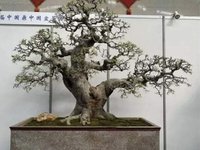I’m working on a project with a trident maple I bought last year. It’s a 3 year old tree so it’s not big, maybe 1/2” caliber. I’m not in love with the shape and plan to chop it at some point. My plan is for a twin trunk on the same root. The root flare is nice and the roots splay out with nice spacing so I’m happy with that.
My question is this:
Would my first step be to grow the tree larger since I’m not planning to keep the top and chop it when it approaches the caliber I want? I have a place where I can plant it in the ground in a sunny spot. I can leave it there for a few years and care for it there and maintain it. At the point of chopping the trunk, do I have to have buds below the chop or will it grow from the trunk without buds? I know bud placement is tricky and not guaranteed. I could chop it slightly higher than needed just in case a second chop is needed. I guess that could also assist me in thickening the trunk, no? Finally, if I do this, would I wait a year after this chop to prune the roots and pot it up?
I’m sorry for the beginner question. I’m sure this is a little on the advanced side but I want to try it.
My next two projects are a Chinese Elm and a cotoneaster microphylla but I’m focusing on this trident right now.
Thank you in advance!
My question is this:
Would my first step be to grow the tree larger since I’m not planning to keep the top and chop it when it approaches the caliber I want? I have a place where I can plant it in the ground in a sunny spot. I can leave it there for a few years and care for it there and maintain it. At the point of chopping the trunk, do I have to have buds below the chop or will it grow from the trunk without buds? I know bud placement is tricky and not guaranteed. I could chop it slightly higher than needed just in case a second chop is needed. I guess that could also assist me in thickening the trunk, no? Finally, if I do this, would I wait a year after this chop to prune the roots and pot it up?
I’m sorry for the beginner question. I’m sure this is a little on the advanced side but I want to try it.
My next two projects are a Chinese Elm and a cotoneaster microphylla but I’m focusing on this trident right now.
Thank you in advance!

